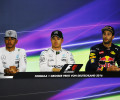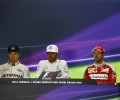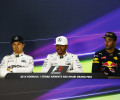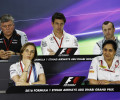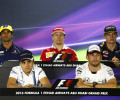F1 - 2016 German Grand Prix - Friday Press Conference
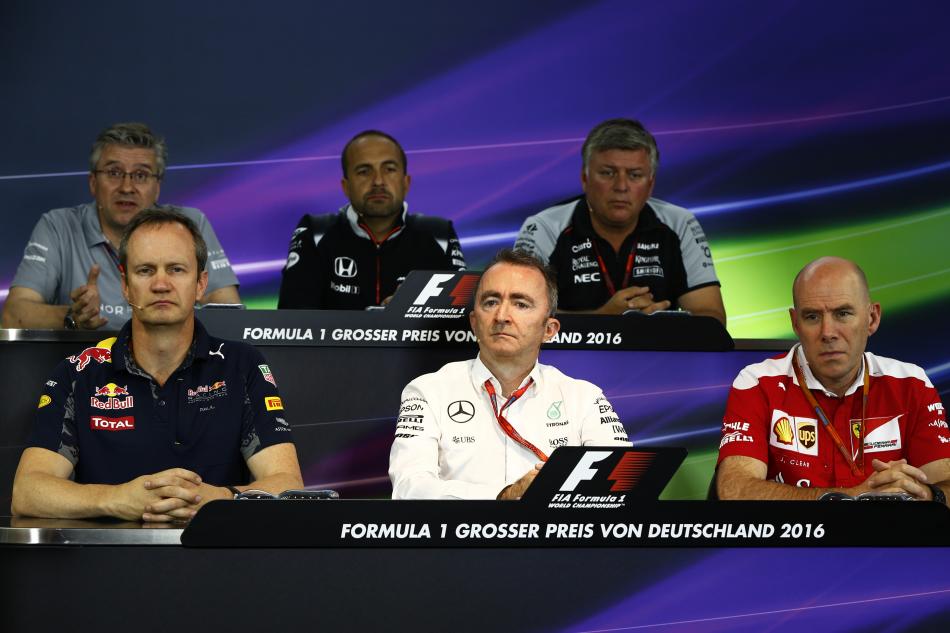
TEAM REPRESENTATIVES – Jock CLEAR (Ferrari), Paul MONAGHAN (Red Bull Racing), Paddy LOWE (Mercedes), Pat FRY (Manor), Matt MORRIS (McLaren), Otmar SZAFNAUER (Force India)
PRESS CONFERENCE
First question to all you gentlemen, it was confirmed yesterday that we will introduce head protection in 2018, not 2017, your thoughts on that please. Pat, why don’t you start?
Pat FRY: Well, I think a lot of research has gone into it over the years. I think we started looking at it in 2013 or something like that, but I think you have got to find the right solution and I think it is just that little bit too early isn’t it to try to rush something through this year.
Paul, you’ve tested the system, your thoughts?
Paul MONAGHAN: It’s close, but it’s not yet a thorough solution and I think if the sport is to do a thorough job then the Halo, or any other derivative thereof, needs a little bit more research, a little bit more work. Yes, we’ve run it at one track, one lap, with our test driver and I wouldn’t have said that’s really the mechanism by which we should introduce such devices and I think it’s the right call to defer it.
Matt, your thoughts?
Matt MORRIS: Yeah, nothing much more to add really. We’re all focused on keeping the car safe and I think we all agree that we need to do something but yeah, it’s just not quite ready yet and it needs a bit more work from the teams and the FIA.
Paddy, your thoughts on the impact on designs and how far you'd got down the road with designs already?
Paddy LOWE: Yeah, I think if we had another 12 months we can clearly do a better job of it. There are things that are not 100% satisfactory. I think the key thing is to make the best of these next 12 months and make something that ticks all the boxes and meets all the requirements of safety and otherwise in the sport and then we take it from there.
Otmar the feeling seems to be that it needs extensive additional track testing for the drivers?
Otmar SZAFNAUER: Well, yeah, the more we test, the more we learn and the better the solution is going to be. Like everyone said in 12 months’ time we’ll be that much further down the road and the solution will be more robust, so it’s probably the right decision.
Final thoughts on the topic, Jock?
Jock CLEAR: I echo everybody else’s thoughts. Obviously the one thing we want to try to do is use those 12 months. As Paddy says, 12 months down the line we’ll know a lot more, but we don’t want to ease off, we don’t want to say ‘OK, so we don’t have to worry about this until August next year’. I think the teams will be responsible with it and I know Charlie will and we’ll use those 12 months and get the job done properly.
Staying with you Jock, obviously we have to address the James Allison situation. You have a new Chief Technical Officer, Mattia Binotto, at Ferrari. What difference will it make?
JC: Difficult to say in the immediate aftermath. Obviously you’re not going to find losing someone like James Allison – someone of his calibre is not going to go unnoticed. So the team is going to have to work pretty hard to support everybody and cover those gaps. In that respect Mattia is going to need help from everybody. We’re going to have to pull together. I don’t think there is any suggestion that Mattia is going to immediately step into the kind of role James was doing – very different background. But the fact is Ferrari has to move forward and we have to make the most of this situation as it is, and I know everybody is committed to pulling together and covering any of those areas where James was very, very strong, and he will be missed, but that’s the challenge for us.
Pat, Manor has gone from racing on its own at the back of the grid to being in a competition now. So how do you make the next step?
PF: It’s quite a large charge from surviving through to competing and that affects the whole organisation, all the way from what we are doing at the factory – from the wind tunnel to the design office, all the reliability side of things – all the way through to the track really. It has knock-on necessities where we need to improve absolutely everywhere through the organisation. There’s a plan for us to grow in a sensible, controlled way but we need to address all those areas – everything from pit stop speed, which we were… to put it a polite way, it was challenging at the beginning of the year, with the same guys and modifying everything – it’s all the detail work that you need to do and it just takes time. The same thing with putting the processes in place so that you can keep a reliable car reliable. There’s a huge task but everyone’s interested. We’re still quite small at the moment. We’re growing quite quickly but we’re still only, whatever… 170 people or something of that order and our next competitor is the thick end of 500 people. There’s a lot to do and we just have to have a sensible plan to grow the organisation to compete sensibly.
Thank you. Paddy, in the press conference after the grand prix last Sunday we clearly saw the tensions between your drivers, over the yellow flags in particular. How do you stop that affecting the two sides of the garage?
PL: I think you just have to try and remain objective with it. The way I see it, with yellow flags, as with any other rule, there is an interpretation that applies and we always work to the limit of that interpretation and if you’re not doing that you’re not racing. We saw even very recently the precedent on that with Hulkenberg in Austria and the amount of speed that was sufficient to satisfy the stewards. We instructed our drivers to take that as guidance and I think Nico did a great job to work to that limit and set the time he needed to in qualifying. I have absolutely no problem with what Nico did and neither did the stewards. I think that was a satisfactory ruling. If at the same time everybody believes that the limit needs to be set at a different level with more margin for marshals and so on, then that’s fine, let’s have that debate and move the line to a different place. I think the important thing is to have that debate away from the immediacy of a particular qualifying lap or a particular racing event.
Paul, coming to you, obviously Red Bull went to Hungary full of optimism that you could race against Mercedes, but it just didn’t happen. Why is that and does it look now that the race this year is just with Ferrari? How do you calibrate your goals now?
PM: I think we did race with Mercedes, just not necessarily as closely as we hoped to. It doesn't really change our goal. Our goal is to get the most out of the car, the drivers and the team at every race – that never changes. It would be nice to take our relative pace from Monaco and move it to Hungary but it remains a competition, we are making prototypes, they evolve, they change, they get better, and Mercedes did a good job and turned up in Hungary with a car that was quicker than ours and they beat us. OK, our race, you may see it as being with Ferrari, yes we would love to beat Ferrari, we will race them and if the opportunity presents we will race Mercedes. Clearly we are looking at the balance of ’16 to ’17 and there’s nothing to stop us learning lessons on this car for next year and beyond. How we deploy our resources is our choice and our balance for next year and some of the bigger projects are going to be on a case-by-case basis. It’s as simple as that.
Matt, has the corner been turned now, and what can you take from what you’ve learned and what you’re learning at the moment through to next year?
MM: I think in terms of our performance, if you look back at the last 18 months, we’ve been gradually improving against pretty much all our competitors. Obviously in the last few races we’ve been genuine top 10 contenders and therefore the limelight has been on us a little bit more. We have some further plans for upgrades this year, so we hope that those continue our progression and then sort of decide after the break in terms of how much resource we keep on this year’s car and move to next year’s car. The team, both Woking and Sakura are working well together and that’s shown in our recent results.
Otmar, you’re in a championship battle chasing after Williams. Your car though seems to be one of the most sensitive to different circuits, some good and some less so. Why is that and what can you do about it?
OS: It’s a little bit to do with the entire package that we have, as well as how we treat the tyres. We’re working hard on making sure that we’re competitive at all circuits and hopefully in the latter half of this year it won’t be so circuit dependent.
Can you let us in on what areas you’re working on?
OS: Well, all the upgrades that we’re going to produce have come now, so it’s just a matter of understanding and tweaking what we have in order to get the most our of the car. We have specific areas that we know we need to work on and we will and can.
QUESTIONS FROM THE FLOOR
Q: (Sandor Meszaros – Autosport ES Formula Magazin) Jock, you’ve spent most of your career fighting Ferrari and now you’re a Ferrari engineer, so can you please sum up the first half of this year at the team?
JC: It would be true to say… obviously I started in January and this half of the season has been, as you see now, dominated by tragic events in March and that affected all of us – affected us emotionally, affected us practically. So I certainly don’t think I’ve seen Ferrari in the most enjoyable light, if you see what I mean, with that shadow hanging over us. But what I have seen is a very motivated group of guys, a very motivated team, a very passionate team, and an unbelievable will to win. As I’ve said recently, that passion can sometimes be our Achilles heel, it can sometimes be something that holds us back, but overall that passion is what is going to get us over the finish line, that passion is what drives people in Ferrari day by day. However tough things are we rely on that and that’s the biggest factor for me, that’s the biggest eye opener for me, just the sheer passion running all the way through the company, it’s fantastic.
Q: (Kate Walker – motorsport.com) I’ve got a question for everyone except Jock please. I asked your colleagues last week about the advantages and disadvantages of warm weather tyre testing, given the dramatic changes that we’ve got to both tyres, downforce levels etc., next year. Could I please have all of your opinions.
PM: I suppose it depends what the teams and what the tyre supplier is really seeking to achieve. If you would like to validate your tyres at the two hardest circuits, which, in my opinion, would be Silverstone and Suzuka, then you’re not necessarily too fussed about the ambient conditions. If you are most worried about the highest temperatures you may encounter, then going somewhere with the track temperature at 50-or-so Celsius is the prudent choice. So, we will learn wherever we go, and in this instance you will learn most about the higher temperature performance of the tyre: how we will treat it; how we look after it; what we do with it; how we do out-laps; how you make it work on a long run. All of that knowledge will be gathered by ourselves and all the teams that ultimately involve themselves. That would be how I judge the conditions of testing.
Paddy?
PL: Firstly, I think the construction of the tyres should be developed in the lab and validated using lab machinery and I think that’s what happens. So the track testing is all about the compounds really. With the mule car testing that is planned with three teams during this autumn and winter, that culminates in a test in Abu Dhabi which will be a final test: all three mule cars will be there. I guess that’s Pirelli’s tick in the box for the range of compounds in those hot conditions. I think Pirelli seem happy with that, as an approval process for their 2017 designs. So if they’re happy, then I think that’s fine with us.
Otmar?
OS: A lot like Paddy says, I think there’s some mule car testing that’s going to happen in Abu Dhabi which traditionally has been hot. And as long as… we’re not a team that are going to participate but as long as Pirelli share all the data equally with everyone and it’s a level playing field we’re happy for that to happen and I’m sure we’ll do a good job and the tyres will be fine for the start of the winter testing and the start of the season.
Matt?
MM: I don’t have much to add. Echoing Paddy’s comments, we obviously look at Pirelli to supply us with a tyre that’s durable and I think this tyre testing that we’ll do is just sort of validation work really. Not much more to add.
Pat?
PF: We’re not participating in the tyre testing either. Similar to Otmar. I think it’s important that you do test as much as you can. I’m sure Pirelli want to know what the information is at the hardest possible tracks really and how the compounds behave. You can only learn so much in the lab. I’m sure Pirelli will learn a lot; I’m sure the teams doing the testing will learn a lot. As long as Pirelli share the information I think it’s going to the beneficial to everyone really. We’ll know the product’s sensible and safe.
Q: (Joe Saward – Auto X) Just a follow-up from that. Pirelli’s working to certain targets of lap times. Is there a danger that the 2017 cars that you lot produce will be better than the tyres?
Jock?
JC: Well, what does that mean? The cars will go as fast as they go on the Pirelli tyres…
The tyres are designed for a certain level of performance. Is it possible that you’re building cars beyond the level of performance they’re designing the tyres to?
JC: I think that’s one of the responsibilities and one of the focuses of the Pirelli testing programme. I think that’s why all the people involved raised that flag very early in this season and said, ‘look, we need to act because, I think with no in-season testing and very limited amounts at the end of the year, that was a very real possibility. I think Pirelli were right to raise that flag and all the teams recognised that this was a genuine concern. We’re all very keen to work with Pirelli to avoid that. I’m quite confident we will avoid that. I think we put the right things in place. Obviously we haven’t embarked on those tests yet. I think we’re the first people to hit the ground, on Monday, with that first test and obviously we will be on a rapid learning curve from there on. But yeah, I think all the teams have taken a responsible view on this to make sure that we, as a group, as a sport, do the best job we can, because obviously we want to go racing next year safely and we want to put on a show and we want to go faster and Pirelli are as keen to do that as we are – so we’re all heading in the same direction.
Paddy, anything to add?
PL: I think we are in a bit of a unique situation where the cars get quicker by regulation. We’ve never done that before. What it’s demanded is a greater level of dialogue than we’ve had before between the teams and Pirelli and the FIA to make sure that our predictions are constantly provided, regularly updated to Pirelli, so that they will be working towards the level of performance that we are developing in the cars. So, if that process works I think it should be fine.
Paul, anything to add?
PM: We agreed within the technical regulations meeting that there would be a regular sharing of the teams’ projected 2017 performance levels with Pirelli, which we supply via the FIA. I think we’ve submitted two dossiers now to inform them of our projected loads. We’ve since had some more data from Pirelli, we’ve put that into the simulation. That’s gone back to them. So, before Ferrari run and the Red Bull car runs in Mugello, there’s been quite a lot of dialogue on how much load’s in the car. So I don’t think there are going to be any unpleasant surprises. I think we’ve got two more data exchanges to have with Pirelli, so I would have said the mechanism in place is one which protects the sport in 2017 as opposed to leaving us free reign to do whatever we want without consultation with Pirelli. So I’m confident we’ll be OK next year.
Just while we’re on the subject of this testing, who’s driving the car next week?
JC: Seb’s driving on Monday, Gutiérrez on Tuesday.
PM: We have Sébastien Buemi in for two days.
PL: It’s not fully confirmed but probably Pascal Wehrlein.
Q: (Dieter Rencken – Racing Lines) Question to Paddy, given what you said about garage objectivity and the fact that you’d instructed your drivers on what to do under whatever yellow flag conditions, is it fair then to assume Lewis’ decision to go and approach the race director twice was a unilateral decision – particularly given that he could have jeopardised Nico’s grid position through that?
PL: It’s my understanding that Lewis did go and see Charlie but it wasn’t in any way to seek a review of Nico’s lap – it was for his own understanding of what should be done in the future, how that should work for him in the future. I think that was regrettable. Personally, he should have kept to advice from the team and we can obtain that from Charlie as necessary. But I don’t think there was any harm done. It was just a misjudgement from that point of view.
Q: (Joe Saward – Auto X) Coming back to that point about the cars being regulated to go faster. We’ve just had a decision – which I think is unique as long as I can remember – where it’s like we’re going backwards in safety for the first time. We have something that could be introduced and isn’t being introduced. Is this a sign of change of the things ahead? Are we responding to the need to be sexier and more exciting? Is that what’s going on here?
Otmar, any thoughts on that?
OS: Are we trying to become more sexy and exciting? What that the question? I don’t think we’re regressing in safety. I think there was a point, not long ago, not this season where the GP2 pole position qualifiers were qualifying not quite halfway up our grid but definitely within it. I think at the time when these regulations were discussed and thought about, it was deemed that we should be going a bit quicker. This is what’s come out of it. I’m not sure that we’re regressing in safety. We did say that the halo would be postponed for the right reasons. That’ll come in, in 2018 and I think over the years we’ve become pretty safe as a formula. So yeah, the cars will go quicker – but not at the cost of safety I don’t believe.
Matt, your thoughts.
MM: Otmar’s right. The reason we’ve made these changes is to try to make a Formula One car head-and-shoulders above some of the other formulae, which was some of the concerns that were raised. In terms of safety, I don’t see that these changes will impact safety. If anything, top speeds might be a little bit lower with the regulations so yes, maybe some of the corner speeds may be a little bit higher – but I don’t think that any of that is going to impact on safety.
Pat?
PF: Not much more to add really. Everyone has got… safety is paramount, people have been working hard and if the question was ‘is delaying the halo an issue?’ I think it’s just not quite ready yet. It’s almost there but not quite there. I think it is just one of those things. It’ll be there next year.
Q: (Sandor Van Es - Formula 1 Magazine, Netherlands) I have a question for Paul about Max Verstappen. Obviously he’s still very young. How do you regard his technical abilities and are there areas where he still has to learn?
PM: I would’ve say all drivers continue to learn. I’d say if you asked the elder ones on the grid “are you still learning?” they’d say “yes”. The curve might change its gradient, shall we say. Max’s feedback is, I would say, very good; for someone of his age it’s particularly good. He is aware of the salient points of his needs amongst the variety of thoughts he may have as he finishes a run or a session. I’d say his racecraft is pretty strong. His ability to withstand pressure was comfortably demonstrated in Spain, Austria, Hungary. So he’s got a very bright future. He’s a very talented young man. I think with Daniel as his team-mate, it’s a very good benchmark for him. Daniel is an exceptional driver. His feedback is very thorough. He picks up on the salient points again. It’s up to us to give them the environment in which they can express themselves and grow as drivers, human beings. And install a sense of team camaraderie and teamwork into them and see where we go.
Q: (Dieter Rencken – Racing Lines) I’m going to talk engines and I realise that you’re not involved with the engine department divisions of your particular teams or operations but if we have a look at the fact that you’ve got four years left on the current engine regulations and the last ones took five years to develop and those were delayed at that stage in any event, at which point do you think a decision should be taken about any engine formula after 2020?
PL: That’s a good question and it’s a big question. I think it is about time we started to talk about the engine beyond this one or power unit, really, we should say. And it does raise some very big considerations: how do we define an engine or power unit that is correct for the sport but also relevant to the kind of power units that we will see in the future in road cars? Do we make remain in some way related attached to that technology which is increasingly electrical or do we go our own way? So there are some very very important questions there. That debate started really with the issue of the sound of these engines when they arrived in 2014. It’s better now than it was back then but it doesn’t match the sound of the old V8s or the V10s but it still raises an interesting debate. I think road cars of the future, at some point not that far off, will be completely silent if they are all electrical so will we want noise, will we associate noise with performance or not? There are some very interesting debates there and I think we need to start that process.
JC: I agree with Paddy. It needs to be thought about. I think what we have learned from this cycle and this era of hybrid engines is that the power units now are very very complicated and it needs a lot of planning and I think we’ll go into those next negotiations with eyes wide open this time, which may be that time round, for a lot of us, and I don’t think there’s anybody who didn’t fall into the category of underestimating what might have been involved, and as such, the sooner we start, the sooner we’ll be aware and the sooner we can come to a solution that will be the best for the sport. So yeah, I absolutely agree and we do need to think about these things, we need to think about it in the context of what the sport needs, what the public wants, what looks sexy if we come to Joe’s point. But fundamentally, it’s still a technological challenge and we need to get the technology right.
PM: It is a debate that we should probably start sooner rather than later and I think Formula One should look at itself and decide what level of power unit performance differentiation does it seek. Should it be a dominant between the teams, should it be a factor within your performance differentiation and then look at how long has it taken these power units to begin to converge – we haven’t converged as yet – and how does that look into the next few years of those next engine rules? If we can establish those perhaps more successfully than we did for the 2014 engine, and maybe different views around my colleagues, then I think the formula could be healthier and then the other debates – how much noise do we have and what spectacle does Formula One wish to create – should become part of that debate? And then it begins to set a cost level and a technology level that the sport thinks is acceptable and how you proceed from there.
MM: I think it is good to start the talks now because it’s important for the engine manufacturers that are already in to see what is happening in the future, because they need reassurance that what we are going to do in the future is still relevant to their business and I think also having visibility of the future could also potentially attract more engine manufacturers into our formula. So I think for our side, the sooner we start discussing this, then the better.
Q: Then just out of interest, clean sheet of paper, what kind of engine would you have post-2020?
OS: A cheap one! Clean sheet of paper, it’s got to be affordable.
PF: I think I just agree with Otmar really. It’s got to be affordable hasn’t it? I meant the costs have snowballed since the normally aspirated engines. It does need bringing back under control to some degree, doesn’t it.
JC: Probably just to echo Paul’s point that we probably don’t want to get in a situation where there are such big differences and visible differences between cars that are put down to power unit, whether that’s exactly what it is or not, but the fact is that the big change a couple of years ago created big big gulfs between cars and we don’t want to see that. Maybe something that brings us closer together or gets us converging much quicker.
Q: (Marco Giachi – Paddock) I have a question about the cockpit safety system. Could you be more precise about the design specs of that system because in the end, what are you looking for: absolute safety, no impact on aerodynamics, low weight? Do you have a typical object to fight against, because in the past a small spring was dangerous for Felipe, a wheel for Surtees and also a fire extinguisher in the seventies was dangerous for poor Tom Pryce, so what do you have in mind as a typical object, as the design spec of that component?
PL: I think the primary target for the halo or whatever other solution may be produced, was for larger objects so the wheel is an obvious one but we’ve done a lot of work over the years to reduce the number of loose wheels, both with the tethers and now double tethers and then with more and more controls over wheel nuts and secondary retention of wheel nuts, so we actually do see far less loose wheels now, so that’s great but the actual major risk exists with whole cars, chassis, so there are a number of incidents that have happened over the last ten years where there have been near misses related to whole cars so this is the target specification. Example being Grosjean and Alonso at Spa, if you remember; it’s this type of incident which is the primary target for the halo device or whatever else we may produce.
Q: (Joe Saward – AutoX) As engineers and designers, you like to make things that look nice and are efficient and go fast obviously, but when you look at the current cars, don’t you think that they’re a sort of mish-mash of everything and don’t you get frustrated at the ugliness of it all? And is the answer really to go with a canopy rather than that Chris Evans-like Cars The Movie halo?
PM: Yes, we like to design things that are nice and efficient. Halo has a modest impact on the aerodynamics, aeroscreen was slightly greater by our measurements anyway, so I don’t think we can create anything that would... you put it in that area which would enhance the car’s performance, should we say. So everybody would accept a loss. The aesthetics form part of our sport. The cars should be, as you noted, sexier. We are making strides towards that in ’17. Is that a dominant reason to reject anything? No. I think as and when you adopt such a system, whether it’s halo, aeroscreen, a derivative thereof, it should be thoroughly developed and tested and therefore become a thorough product and at that point, you’ve already accepted the consequences of fitting it and you’ve dealt with your safety cases. The drivers have gone round numerous laps with it, gone through Monaco in the tunnel, gone up the hill at Spa and so on and so forth and you feel you have a complete solution. At that point, you can deploy it and as engineers, when you have a thorough product you’re more than happy with it and you move on and that’s the part you fit to a Formula One car and that’s that.
PF: I think it’s just... the situation that we’re in is not quite there as has been said before. The sexy car is the one that wins, isn’t it, let’s face it. There have been some ugly cars that have won but when you look back they are quite sexy.
Q: (Silvia Arias – Parabrisas) I would like to know from all of you gentlemen, I would like to know if the strategy group is talking about no restrictions radio in the future? What is your opinion about that, please? Is it going to make your work easier for you?
JC: Yeah, not in the future, in the now. Today those regulations were freed up and again, as I said last week, for sure the regulation as it was made life difficult for us and I think what you’ve seen in the last couple of weeks in the debates and the arguments and of course what’s happened in the last two days has demonstrated that people have said, yup, OK, that’s probably the case, it’s now getting a bit too difficult to manage the cars, the drivers were spending a lot of time trying to understand what to do in the cockpit rather than just drive the things fast so to answer your question, this opening up of the radio coms has made thing so much easier for us. I think, like all of these things, you can’t unlearn what you’ve learned and actually, we’ve made ourselves a lot more efficient in the meantime. We’ve actually managed to get a situation where a lot of these things can be handled pretty easily and pretty automatically anyway, which I think was the objective so we’re in a better place than we were a year ago or Spa when it was brought out about a year ago. We won’t forget those things we’ve learned but yeah, there will be a lot of situations now which we can manage much more easily and just allow the drivers to get on with racing.
OS: Well, I think it’s a lot to do with the fans. Originally the communications were restricted in order for the fans to have a better show. Maybe perhaps the drivers having a more difficult time and then mixing it up a bit and I think apart from Lewis threatening to change all switches, which was a bit entertaining the rest of it kind of took away from the fans because the fans suddenly realised that they enjoyed listening to the drivers communicating with their engineers often and that was taken away. So I believe the reason to go back to it is to give that enjoyment back to the fans. Jock is right, we’re a lot more efficient now with the way we communicate and that’s a good thing, but hopefully that communication between engineer and driver will again be on the airwaves and the fans will enjoy it.
PL: Yeah, I agree. The situation has unfortunately become too complex to manage, it was too cumbersome. We had huge lists on the pit wall to decide and decode whether what we were going to say would be legitimate or not. We got it wrong in Silverstone through really a nuance of phraseology so I think what we welcome is clarity one way or the other, and you really either have the extreme of no communication or all communication and I think for the fans, it’s better to go the way we’ve gone. The radio’s only available to be policed because the teams originally by gentleman’s agreement, made it available for broadcast, otherwise nobody would have known what we were saying in the first place.
MM: I sort of echo what everybody else has said. I think it sort of got away from us a little bit, I think. Initially when the change was brought in, there was a chance of it making things a little bit more interesting but it has just got unbelievably complicated and difficult for the drivers to do it for us. Ultimately, the reason it was brought in was to make the racing more exciting and what we don’t want is cars just stopping in the race and not be able to do anything about it and also there’s the safety side as well. Clearly the last race, it was very difficult for us and we just wanted the car to be safe and then it all sort of spiralled into a bit of a mess for us. So I think basically the decision that was made yesterday was the right decision. I think common sense has prevailed.
PM: I’m pleased for the fans that we’ve got radio communications back. I think it adds something to the show we put on. I’m pleased the mute button has been disallowed so what is said is available. Looking at it in a slightly different way as well, it enables the teams to continue to participate in the race. It is a team event, the driver can’t exist without the team behind him so the team is able to influence the performance and/or reliability of the car during the race and that seems entirely reasonable to me, so I’m pleased with the decision, yes.
PF: Well I think that with the level of complication of the cars now and the reliability aspects of it it has become very difficult to manage that situation sometimes without the radio. We’ve had a few examples this year, ourselves with brake issues that we’re struggling to manage, what we can say and what we can’t say, and it just seems overly restricted not to be able to sort out a serious reliability issue. We have similar lists as Paddy had on the pit wall: can we say this or can we say that? Delays like that are not what you need really when you’re trying to fight a problem, so I think it’s going to help everyone now, it’s clear.
Q: (Dieter Rencken – Racing Lines) The last two race weekends were disrupted by red flags and safety cars due to the aquaplaning. For next year, we’re going to tyres which are two inches wider which I understand will increase the incidence of aquaplaning. Are we actually going the right way by going with the wider tyres, particularly in wet weather?
JC: I think this comes back to our dialogue with Pirelli and the development we do with Pirelli. I think there’s probably some simple physics that supports your idea, that it is going to be more of a challenge for Pirelli. They’ve tabled specific wet tests, in fact our test on Monday, Tuesday is a wet test for that very reason, because it’s right up there, it’s obviously a safety issue as well. I can’t add any more than to say that dialogue was brought up and kicked off for this very reason and we’re comfortable as I think and hope Pirelli are comfortable, that the teams are doing everything they can to support it and that at the end of the year we will be in a position to have safe tyres and performant tyres.

 Facebook
Facebook Twitter
Twitter
